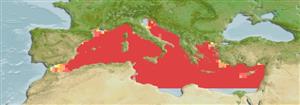Classification / Names
Common names from other countries
Main reference
Size / Weight / Age
Max length : 240 cm TL male/unsexed; (Ref. 4770); common length : 200 cm OT male/unsexed; (Ref. 43); max. published weight: 70.0 kg (Ref. 43)
Environment
Marine; pelagic-oceanic; oceanodromous (Ref. 51243); depth range 0 - 200 m (Ref. 43)
Climate / Range
Deep-water, preferred ?; 46°N - 32°N, 6°W - 36°E (Ref. 43)
Distribution
Mediterranean Sea: considerably abundant around Italy. No confirmed report from the Black Sea. No adults have been reported east of the Ionian Sea. Highly migratory species, Annex I of the 1982 Convention on the Law of the Sea (Ref. 26139). Reportedly caught from the Aegean Sea (Pennetti, pers. comm.).
Countries | FAO areas | Ecosystems | Occurrences | Introductions
IUCN Red List Status (Ref. 115185)
Threat to humans
Harmless
Human uses
Fisheries: minor commercial
More information
ReferencesAquacultureAquaculture profileStrainsGeneticsAllele frequenciesHeritabilityDiseasesProcessingMass conversion
Tools
Special reports
Download XML
Internet sources
Estimates of some properties based on models
Phylogenetic diversity index
PD50 = 0.5630 many relatives (e.g. carps) 0.5 - 2.0 few relatives (e.g. lungfishes)
Trophic Level
4.5 ±0.80 se; Based on food items.
Resilience
Low, minimum population doubling time 4.5 - 14 years (Assuming tmax>10)
Vulnerability
Moderate to high vulnerability (45 of 100)
Price category
